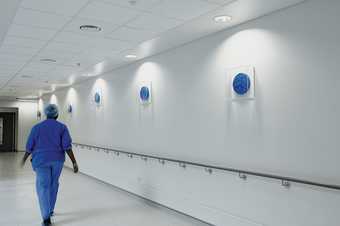
A member of the medical team at the Royal London Hospital oberves Roger Hiorns's Untitled 2012, discarded office clocks coated in copper sulphate crystals, commissioned by Vital Arts, Barts Health NHS Trust
Photo: Jess Bonham
Deep in the isolation ward at Barts Hospital Cancer Centre, a suite of 65 drawings by Amalia Pica runs playfully across the walls, and gathers in groups of three in each bedroom. These quirky works, built from a network of rubber-stamp markings, are individually engaging; hovering between abstraction and images of landscape, they offer viewers a puzzle to disentangle. When put together, their joyful dynamic has delighted patients, who are confined within the area for several weeks at a time.
Florence Nightingale, the social reformer and founder of modern nursing is often cited for her belief in the positive effects of art in a hospital environment. In her Notes on Nursing written in 1859, she wrote how the ‘variety of form and brilliancy of colour in the objects presented to patients are actual means of recovery.’ Art in hospitals today, however, should be much more ambitious than simply providing shape and hue. There is increasing evidence that exposure to thoughtfully selected art helps to reduce stress, decreases the use of analgesics and can accelerate recovery. Pica’s installation is one such example of carefully considered art: she spent months developing her piece after frequent visits to the hospital, meeting both staff and patients.
The role of art in hospitals could be broadened further still: as key civic spaces, they are ideal areas to introduce new audiences to contemporary art. These public buildings are poised to offer patients, visitors, and staff – and the wider hospital community – the possibility of a cultural experience they might not otherwise have accessed. People tend to be in hospital unwillingly, where they might encounter art unwittingly. In a clinical context, art frequently functions to distract patients. Yet, it should attempt not just to pique interest, but also to open horizons. Rather than argue merely for the inclusion of (all too often insipid) art in hospitals, the conversation needs to shift to an argument for the introduction of art that is culturally significant. Ideally, every hospital would have an in-house team of art professionals, trained in art history, that would contribute to the ideas that pulse through contemporary art. Each team, ideally, would commission innovative, site-specific and patient-responsive works that are born of research and a long engagement with the hospital context. These commissions would be by artists whose work is not found in other hospitals, thus generating programmes that are innovative – and distinctive.
Catsou Roberts is Director of Vital Arts, the charitably funded arts organisation for Barts Health NHS Trust, which commissions works by established and emerging artists across five hospitals in London’s East End. Vital Arts, a Tate Exchange Associate, will host a series of artist-led workshops and activities at Tate Exchange, Tate Modern, 19 – 20 May.
